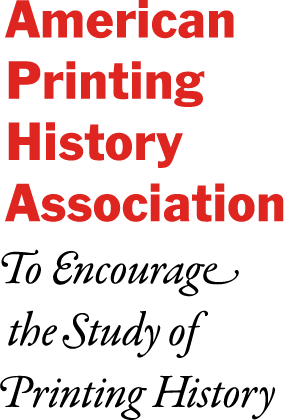
Cary curators Steve Galbraith and Amelia Fontenal accept APHA’s Institutional Award from APHA president Robert McCamant, January 30, 2016. (Nina Schneider)
APHA Awards committee statement forthcoming.

Jadwiga Tryzno addresses APHA members after receiving the 2015 Institutional Award from President Robert McCamant. (Gwido Zlatkes) | Book Art Museum English language video.
Introduction by Michael Thompson, Chair, Award Committee
New York, January 24, 2015
Jack Ginsburg, a noted collector of artists’ books from South Africa, is a person old enough to have lived most of his life during the apartheid regime in his home country. In a presentation he made recently, not too far from here at a conference sponsored by the Center for the Book Arts, he commented that during the apartheid era when he returned home to South Africa from abroad he was always asked by immigration authorities two questions:
Do you have any guns?
Do you have any books?
Both, it seems were viewed as threats to the authoritarian regime.
In the hands of an individual not controlled by the state a printing press is a weapon, and we in the American Printing History Association should not forget that. We should not let the first word in our title, “American,” make us complacent, or allow us to forget the challenges faced by others like us living in political environments that are suspicious of, and actually hostile to, the uncensored printed word.
In a country where fine printing and historic printing techniques were almost entirely eradicated under communism, the Book Art Museum in Łódź has taken on the important role of ensuring the continuity of the art of fine printing. They restore and preserve vintage printing equipment, cultivate printing skills, and perform outreach to the community. The museum originated from Correspondance des Arts, a small press started by the husband and wife team of artists Janusz and Jadwiga Tryzno in 1980, at a time when the Tryznos were actively involved in underground printing for the Solidarity movement. Their press became a Foundation in 1990, and in 1993 the Tryznos opened the Book Art Museum in Łódź.
Currently the Correspondance des Arts publishes artists’ books with original graphic material and with unconventional bindings of various sizes and shapes, but always related to the history of the book. The press makes books that question the intersection of various artistic disciplines, like images, sounds, and motion, and such books then experiment with the relationship between and among them. These books and many artists’ books made by other artists and presses are collected in the Book Art Museum where they are used for lectures, presentations, and educational meetings.
The 2015 winner of the institutional award from the American Printing History Association is the Book Art Museum of Łódź represented by Jadwiga Tryzno.

David Godine accepts APHA’s 2014 Institutional Award from President Robert McCamant. (Joel Mason)
Introduction by Michael Thompson, Chair, Award Committee
New York, January 25, 2014
Publishing in print or in electronic media is today mostly undertaken by one of six large firms: Hachette, HarperCollins, Macmillan, the Penguin Group, Random House, and Simon and Schuster. Known as the Big Six, only two are US companies (Simon and Schuster and HarperCollins), two are German, one British, and one French. Coincidentally or not, that arrangement and order of arrangement roughly follows the size of the respective market capitalizations of the stock markets in the four countries involved. In contrast, on its website, David R. Godine, Inc., describes itself as “a small publishing house located in Boston, Massachusetts” producing about twenty to thirty titles yearly that “reflect the individual tastes and interests of its president and founder David R. Godine.” This is not, in other words, just another business venture.
Those tastes and interests include art and photography, music and food, Judaica, nature and gardening, fiction and poetry, and what Mr. Godine calls “regional books” (which of course to him only means New England). Perhaps more to the point here, at APHA, the interests include typography, with such backlist titles as An Essay on Typography by Eric Gill and Personal Impressions: The Small Printing Press in Nineteenth Century America by Elizabeth M. Harris, and many other titles. David R. Godine, Inc. is also the exclusive licensed distributor for the backlist of the Black Sparrow Press, founded in 1966 by John Martin to publish out-of-the-mainstream writers in small finely printed editions. Black Sparrow remains alive as an imprint of Godine.
The eponymous originator of this publishing house, David R. Godine himself, began his professional life, after graduating from Dartmouth and Harvard, with Leonard Baskin and Harold McGrath but soon opened his own print shop in an abandoned barn where he printed, by letterpress, his first books.
Among the titles involving printing history that have been published by this institution are Into Print: Selected Writings on Printing History, Typography and Book Production by John Dreyfus (1995), Suzuki Harunobi: A Selection of His Color Prints and Illustrated Books by Jack Hiller (1970), Art of the Printed Book 1455-1955: Masterpieces of Typography . . . from the Morgan Library with an essay by Joseph Blumenthal (1974), The Printed Book in America by Joseph Blumenthal (1977), and Early Children’s Books and Their Illustration by David Gottleib (1975), just to name a few.
In recognition of this long dedication to keeping publishing alive and of human proportions, and in recognition of the role printing history has played in that work, I am happy to announce that the 2014 institutional award by the American Printing History Association will be given to David R. Godine, Inc.



